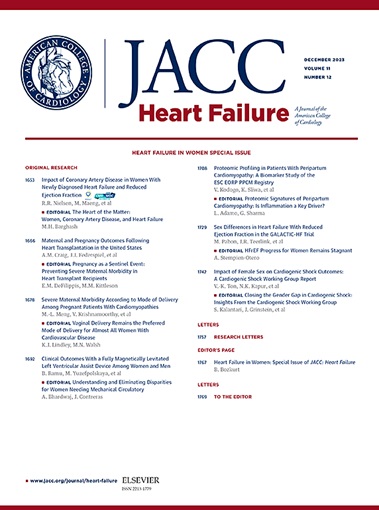预测风险,临床前心力衰竭措施和心力衰竭事件
IF 11.8
1区 医学
Q1 CARDIAC & CARDIOVASCULAR SYSTEMS
引用次数: 0
摘要
背景prevention -HF(预测心血管事件风险-心力衰竭)风险评估与临床前心力衰竭(HF)的关系以及临床前心力衰竭测量是否增加了prevention -HF的预测效用尚不明确。本研究的目的是评估prevention -HF风险估计与临床前HF之间的关系,检查临床前HF测量值如何对应prevention -HF类别中的绝对HF风险,并确定它们是否提供了prevention -HF评分之外的预测价值。方法:作者对2,714例ARIC(社区动脉粥样硬化风险)访问的5名参与者进行了前瞻性分析,这些参与者年龄80岁,无基线心血管疾病。临床前HF的定义是心脏生物标志物升高(前b型利钠肽n端≥125 pg/mL或高敏感性心肌肌钙蛋白T≥22 ng/L/≥14 ng/L,男性/女性)和/或超声心动图异常。在prevention -HF 10年风险分类(<7.5%,≥7.5% - <10%,≥10% - <15%,≥15% - <;20%和≥20%)中,我们评估了临床前HF患病率,并比较了有和无临床前HF的10年HF发病率。我们通过在prevention -HF中加入临床前HF测量来评估预测效用的变化。结果平均年龄为74岁,63%为女性,22%为黑人成年人。较高的prevention -HF风险与较高的临床前HF患病率相关,在prevention -HF≥20%的人群中,生物标志物升高加超声心动图异常的患病率最高(37%)。在平均9.9年的随访中,发生262例心衰事件。在prevention -HF类别中,临床前HF测量与绝对HF风险密切相关:在prevention -HF≥20%的患者中,无临床前HF的HF发病率(每1000人年)为9.5,生物标志物升高且超声心动图异常的发生率为51.5。在prevention - hf中加入心脏生物标志物可改善风险识别(C统计变化0.69 ~ 0.75;P < 0.001)和再分类(分类净再分类指数:0.17;95% CI: 0.09 ~ 0.26),加入超声心动图措施可进一步改善。结论临床前HF测量表明,在预防-HF分类中,HF的绝对风险较高,并增强了HF的风险预测。本文章由计算机程序翻译,如有差异,请以英文原文为准。
Predicted Risk, Preclinical Heart Failure Measures, and Incident Heart Failure
Background
The association of PREVENT-HF (Predicting Risk of Cardiovascular Events–Heart Failure) risk estimates with preclinical heart failure (HF) and whether preclinical HF measures add to the predictive utility of PREVENT-HF remain undefined.
Objectives
The aims of this study were to evaluate the association between PREVENT-HF risk estimates and preclinical HF, to examine how preclinical HF measures correspond to absolute HF risk within PREVENT-HF categories, and to determine whether they provide predictive value beyond the PREVENT-HF score.
Methods
The authors performed a prospective analysis of 2,714 ARIC (Atherosclerosis Risk In Communities) Visit 5 participants <80 years of age, without baseline cardiovascular disease. Preclinical HF was defined by elevated cardiac biomarkers (N-terminal of pro-b-type natriuretic peptide ≥125 pg/mL or high-sensitivity cardiac troponin T ≥22 ng/L/≥14 ng/L in men/women) and/or abnormal echocardiographic findings. Within PREVENT-HF 10-year risk categories (<7.5%, ≥7.5% to <10%, ≥10% to <15%, ≥15% to <20%, and ≥20%), we assessed preclinical HF prevalence and compared 10-year HF incidence rates for those with and without preclinical HF. We assessed changes in predictive utility by adding preclinical HF measures to PREVENT-HF.
Results
The mean age was 74 years, with 63% women, and 22% Black adults. Higher PREVENT-HF risk was associated with higher preclinical HF prevalence, with the highest prevalence of combined elevated biomarkers plus abnormal echocardiograms (37%) in those with PREVENT-HF ≥20%. Over a median follow-up of 9.9 years, 262 HF events occurred. Within PREVENT-HF categories, preclinical HF measures were strongly associated with absolute HF risk: among those with PREVENT-HF ≥20%, HF incidence rates (per 1,000 person-years) were 9.5 with no preclinical HF and 51.5 with elevated biomarkers plus abnormal echocardiography. Adding cardiac biomarkers to PREVENT-HF improved risk discrimination (C statistic change 0.69 to 0.75; P < 0.001) and reclassification (categorical Net Reclassification Index: 0.17; 95% CI: 0.09-0.26), with modest further improvement from adding echocardiographic measures.
Conclusions
Preclinical HF measures indicate higher absolute HF risk within PREVENT-HF categories and enhance HF risk prediction.
求助全文
通过发布文献求助,成功后即可免费获取论文全文。
去求助
来源期刊

JACC. Heart failure
CARDIAC & CARDIOVASCULAR SYSTEMS-
CiteScore
21.20
自引率
2.30%
发文量
164
期刊介绍:
JACC: Heart Failure publishes crucial findings on the pathophysiology, diagnosis, treatment, and care of heart failure patients. The goal is to enhance understanding through timely scientific communication on disease, clinical trials, outcomes, and therapeutic advances. The Journal fosters interdisciplinary connections with neuroscience, pulmonary medicine, nephrology, electrophysiology, and surgery related to heart failure. It also covers articles on pharmacogenetics, biomarkers, and metabolomics.
 求助内容:
求助内容: 应助结果提醒方式:
应助结果提醒方式:


